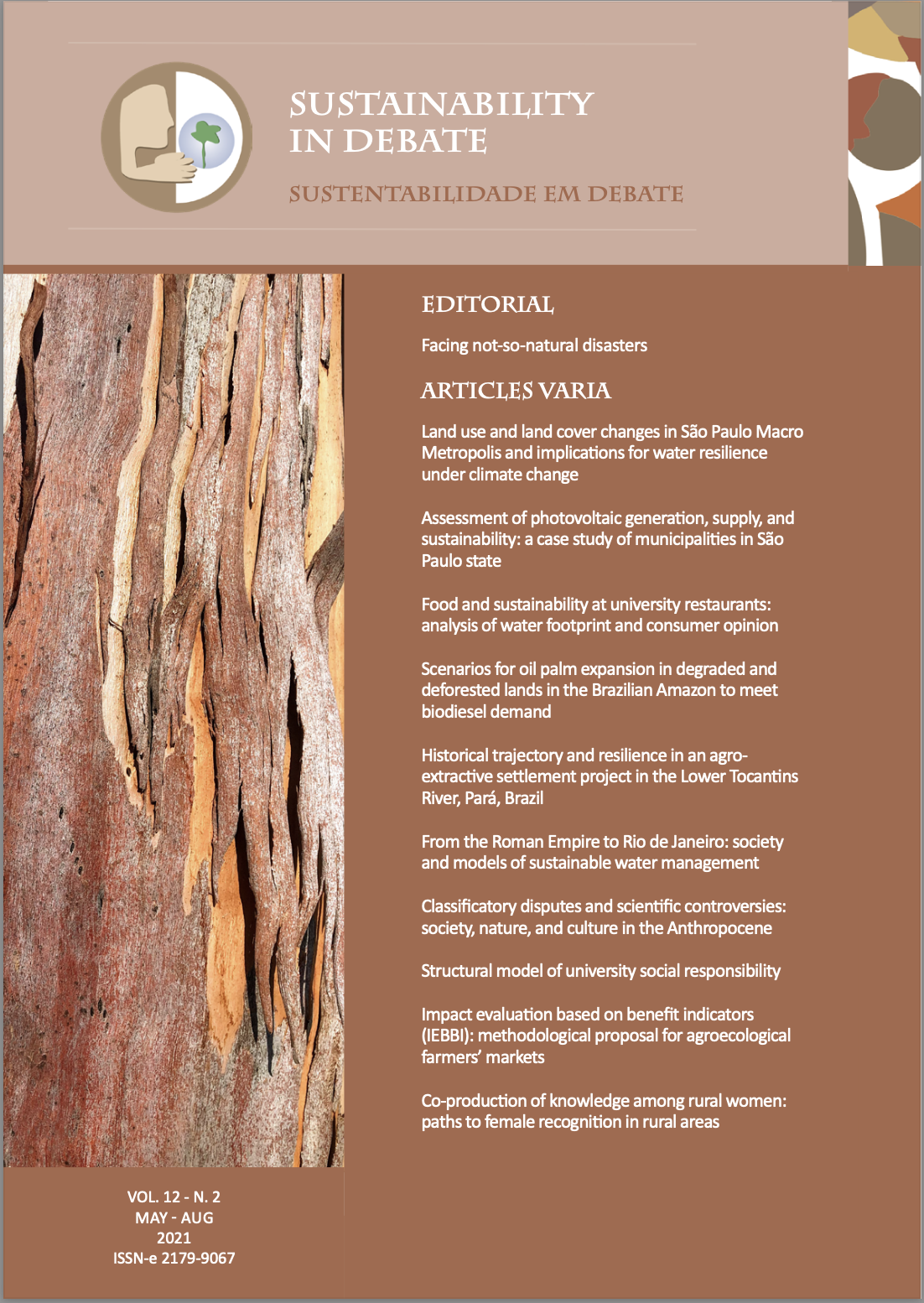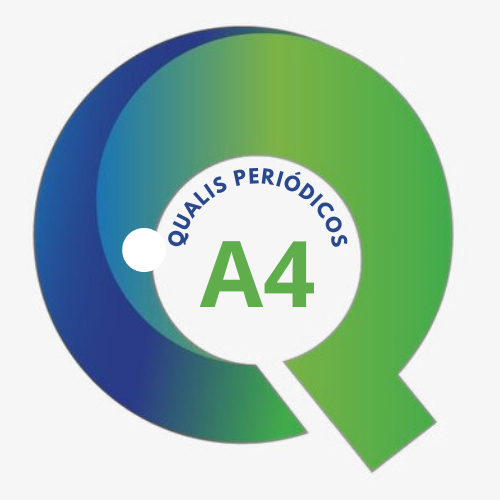Land use and land cover changes in São Paulo Macro Metropolis and implications for water resilience under climate change
DOI:
https://doi.org/10.18472/SustDeb.v12n2.2021.32146Palabras clave:
São Paulo Macro Metropolis. Land use and land cover changes. Ecosystem services. Water supply.Resumen
The São Paulo Macro Metropolis (MMP) is a geographical arrangement that brings together the most significant Brazilian socioeconomic figures and faces numerous challenges, such as heavy pressure on natural resources. Through compilation, spatialization and cross-referencing of data, this work assessed time series of land use and land cover of the last decades, the water supply status in an urban environment and climate data projection for MMP. Municipalities with different profiles were identified: those with positive final balances and those with negative final balances about the maintenance of their natural areas. Furthermore, more than half of the municipalities of the MMP have low water supply assurance, which can be aggravated due to climate change, as predicted in several climate models. The characterization of municipalities based on this information allowed identifying which of them are the most vulnerable, and these results indicate paths for coordinated actions at local and regional levels to increase water resilience in the macro-region.
Descargas
Citas
AGÊNCIA NACIONAL DE ÁGUAS. Atlas Brasil: abastecimento urbano de água. Available at: <http://atlas.ana.gov. br/Atlas/forms/Home.aspx>. Accessed on: 10 jun. 2020.
AHMADI, E. et al. An Integrated Planning Framework for Sustainable Water and Energy Supply. Sustainability, v. 12, p. 4295, 2020.
AMATO-LOURENÇO, L. F. et al. Metrópoles, cobertura vegetal, áreas verdes e saúde. Estudos Avançados, v. 30, n. 86, p. 113-130, 2016.
BRASIL. Lei n. 14.119, de 13 de janeiro de 2021. Diário Oficial [da] República Federativa do Brasil. Poder Executivo, Brasília, DF, seção 1, página 7, 14 de janeiro de 2021.
BRASIL. Ministério da Indústria, Comércio Exterior e Serviços. Balança comercial do MDIC sobre Cajamar – Março de 2018. Ministério da Indústria, Comércio Exterior e Serviços. 1 de abril de 2018. Consultado em 02 de maio de 2018.
BRASIL. Ministério do Meio Ambiente. Roteiro para a elaboração dos Planos Municipais de Conservação e Recuperação da Mata Atlântica. Brasília: MMA, 2013.
CARMO, R. L. do; DAGNINO, R. de S.; JOHANSEN, I. C. Transição demográfica e transição do consumo urbano de água no Brasil. Revista Brasileira de Estudos de População, v. 31, n. 1, p. 169-190, 2014a.
CARMO, R. L. do; ANAZAWA, T. M.; JOHANSEN, I. C. Seca nas metrópoles: materialização de um desastre anunciado. Waterlat-Gobacit Network Working Papers, 2014b.
CARVALHO, P. F.; BRAGA, R. Perspectivas de gestão ambiental em cidades médias. Rio Claro: Deplan/IGCE/ Unesp, p. 95-109, 2001.
CHOU, S. C. et al. Evaluation of the ETA simulations nested in three global climate models. American Journal of Climate Change, v. 3, n. 5, p. 438-454, 2014a.
CHOU, S. C. et al. Assessment of climate change over South America under RCP 4.5 and 8.5 downscaling scenarios. American Journal of Climate Change, v. 3, n. 5, p. 512-525, 2014b.
CODAZZI, J. Proposta do novo zoneamento em São José é ‘retrocesso ambiental’, apontam especialistas. 2019. Available at: <https://www.ovale.com.br/_conteudo/politica/2019/07/83951-zoneamento--proposta-e- retrocesso-ambiental--apontam-especialistas.html>. Accessed on: 27 out. 2019.
COSTA, M. A. et al. Caracterização e Quadros de Análise Comparativa da Governança Metropolitana no Brasil: análise comparativa das funções públicas de interesse comum (Componente 2) – RM do Rio de Janeiro (Relatório de Pesquisa). Rio de Janeiro: Institute for Applied Economic Research – Ipea. Rio de Janeiro: Ipea, 2015.
COUTINHO, M. P. et al. Áreas de inundação no trecho paulista da Bacia do Rio Paraíba do Sul e nascentes do Cadastro Ambiental Rural. Urbe: Revista Brasileira de Gestão Urbana (Brazilian Journal of Urban Management), 2018.
CPTEC/INPE. Projeções de Mudança do Clima para a América do Sul Regionalizadas pelo Modelo ETA. Projeta, 2020. Available at: <https://projeta.cptec.inpe.br/>. Accessed on: maio 2020.
DERSA. Aprimoramento do traçado da Nova Tamoios Contornos reduz impactos socioambientais. 2013. Available at: <http://www.dersa.sp.gov.br/comunicacao/noticias/novidades/aprimoramento-do-tracado-da- nova-tamoios-contornos-reduz-impactos-socioambientais/>. Accessed on: 23 out. 2019.
DI GIULIO, G. M. et al. Mudanças climáticas, riscos e adaptação na megacidade de São Paulo, Brasil. Sustentabilidade em Debate, v. 8, p. 75-87, 2017.
EMPLASA. Macrometrópole Paulista. Available at: https://emplasa.sp.gov.br/MMP. Accessed on: 02 out. 2019.
FAO. The Water-Energy-Food Nexus: a new approach in support of food security and sustainable agriculture. Food and Agriculture Organization of the United Nations. 2014. Available at: http://www.fao.org/3/a-bl496e.pdf. Accessed on: 04 jul. 2020.
FARIA, L. Planejamento estratégico, estatuto da cidade e plano diretor: métodos e instrumentos de organização e gestão do espaço urbano. Caminhos de Geografia Uberlândia, v. 10, n. 32, dez/2009, p. 162-170. Available at: http://www.ig.ufu.br/revista/caminhos.html. ISSN 1678-6343
FARINACI, J. S. As novas matas do estado de São Paulo: um estudo multiescalar sob a perspectiva da teoria da transição florestal. Campinas, SP: [s.n.], 2012.
FOLKE, C. et al. Adaptive governance of social-ecological systems. Annual Review of Environment and Resources, v. 30, p. 441-473, 2005.
FRACALANZA, A. P.; FREIRE, T. M. Crise da água na Região Metropolitana de São Paulo: a injustiça ambiental e a privatização de um bem comum. Geousp – Espaço e Tempo (on-line), v. 19, n. 3, p. 464-478, 2015.
GCOM. Pacto Global de Prefeitos pelo Clima e a Energia. Available at: http://pactodealcaldes-la.eu/pt-br/>. Accessed on: abr. 2021.
GRAAFLAND, A. “Mapping Urban Complexity”. In: SECOND MEGACITIES CONFERENCE 2006, 2006, Guangzhou. Second Megacities Conference – Proceedings. Guangzhou, 2006.
HOGAN, D. J. et al. Urbanização e vulnerabilidade socioambiental: o caso de Campinas. In: HOGAN, D. J. et al. (org.). Migração e ambiente nas aglomerações urbanas. Campinas: Nepo/Unicamp, p. 395-418, 2001.
JACOBI, P. R.; TORRES, P.; GRESSE, E. G. Governing Shallow Waters: SDG 6 and Water Security in São Paulo. In: Unesco i-WSSM. 2019. Water Security and the Sustainable Development Goals. Global Water Security Issues (GWSI). Case Studies, Unesco i-WSSM, Daejeon.
JARDIM, M. H. Pagamentos por serviços ambientais na gestão de recursos hídricos: o caso do município de Extrema – MG. Dissertação (Mestrado em Desenvolvimento Sustentável) – Centro de Desenvolvimento Sustentável, Universidade de Brasília, Brasília, DF, 2010. Available at: https://repositorio.unb.br › bitstream › 2010_Marina. Accessed on: jun. 2021.
KOWARICK, L. Viver em risco: sobre a vulnerabilidade no Brasil urbano. 2002. Available at: <http://www.uff.br/ observatoriojovem/sites/default/files/documentos/20080627_viver_em_risco_1.pdf>. Accessed on: 20 dez. 2017.
LEONEL, A. L.; ZIONI, S.; MOMM, S. Macrometrópole Paulista: apontamentos sobre uma nova unidade de planejamento. In: XVIII ENANPUR 2019. Anais [...], 2019. ISSN: 1984-8781.
LIMA, A. P. M. de. Pagamento por Serviços Ambientais Hídricos no Brasil: experiências iniciais e os desafios do monitoramento. In: XX SIMPÓSIO BRASILEIRO DE RECURSOS HÍDRICOS. Available at: https://ainfo.cnptia. embrapa.br/digital/bitstream/item/94057/1/pagamento-por-servicos.pdf. Accessed on: jun. 2021.
LIRA, P. et al. Land-use and land-cover change in Atlantic Forest landscapes. Forest Ecology and Management, v. 278, p. 80-89, 2012. 10.1016/j.foreco.2012.05.008.
LYRA, A. et al. Climate change projections over three metropolitan regions in Southeast Brazil using the non- hydrostatic ETA regional climate model at 5-km resolution. Theoretical and applied climatology, v. 132, n. 1-2, p. 663-682, 2018.
MARQUES, A. R. et al. Governança da água no Vale do Paraíba Paulista: rede de atores e sistemas socioecológicos. Ambiente e Sociedade [on-line], v. 23, 2020, e01381. Epub June 08, 2020. ISSN 1809-4422. https://doi. org/10.1590/1809-4422asoc20190139r1vu2020l2de.
MILLENNIUM ECOSYSTEM ASSESSMENT. Ecosystems and Human Well Being: synthesis. Island Press, 2003.
PAVANI, B. F. et al. Pagamentos por serviços ecossistêmicos para proteção de recursos hídricos na área de proteção ambiental da bacia do Rio Paraíba do Sul. Ambiente & Sociedade, São Paulo. v. 23, 2020, Special Issue n 2020;23:e01341.
PBMC. Mudanças Climáticas e Cidades. Relatório Especial do Painel Brasileiro de Mudanças Climáticas. RIBEIRO, S. K.; SANTOS, A. S. (ed.). PBMC, Coppe – UFRJ. Rio de Janeiro, Brasil. 2016, 116p. ISBN: 978-85-285-0344-9.
POWER, A. G. Ecosystem services and agriculture: tradeoffs and synergies. Philosophical Transactions of the Royal Society B, v. 365, p. 2959-2971, 2010. Available at: http://rstb.royalsocietypublishing.org/content/365/1554/2959. full. Accessed on: dez. 2017.
PROJETO MAPBIOMAS. Coleção 4 da Série Anual de Mapas de Cobertura e Uso de Solo do Brasil. Available at: http://mapbiomas.org. Accessed on: set. 2019.
ROCKWELL, R. Cities and global environmental changes, 1999.
RODRIGUES, E. A.; VICTOR, R. A. B. M.; PIRES, B. C. C. A Reserva da Biosfera do cinturão verde da cidade de São Paulo como marco para a gestão integrada da cidade, seus serviços ambientais e o bem-estar humano. São Paulo em Perspectiva, v. 20, n. 2, p. 71-89, 2006.
SAMPAIO, M. R. A.; PEREIRA, P. C. X. Habitação em São Paulo. Estudos Avançados, v. 17, n. 48, p. 167-183, 2003. SÃO PAULO (Município). SECRETARIA MUNICIPAL DO VERDE E MEIO AMBIENTE. Guia dos Parques Municipais de
São Paulo. 3rd. ed., 2012.
SORIANO, É. et al. Identificação e análise da comunicação do risco de desastres naturais em municípios do estado
de São Paulo (Brasil). Revista da Anpege, [S.l.], v. 12, n. 19, p. 390-408, jun. 2017. ISSN 1679-768X. Available at: http://ojs.ufgd.edu.br/index.php/anpege/article/view/6387/3338. Accessed on: 23 out. 2019. https://doi. org/10.5418/RA2016.1219.0016.
SOUSA JÚNIOR, W. C. Water and Energy Nexus under Climate Change Scenarios: lessons from Brazil. New Water Policy & Practice, v. 4, n. 2, 2018.
SOUSA JÚNIOR, W. C. Water: drought, crisis and governance in Australia and Brazil. Water, v. 8, n. 11, p. 493-502, 2016.
THE STATE OF THE WORLD’S CITIES 2004/2005. Globalization and urban culture. UN-Habitat. ISBN 1-84407-159-6.
TORRES, P. H. C.; JACOBI, P. R. Dossiê especial fórum de governança ambiental da Macrometrópole Paulista. Editorial n. 2020;23:e0002. Ambiente & Sociedade, São Paulo. v. 23, 2020.
UNDRR. The ten Essentials for Making Cities Resilient. Making Cities Resilient: my city is getting ready. Available at: https://www.unisdr.org/campaign/resilientcities/toolkit/article/the-ten-essentials-for-making-cities-resilient. Accessed on: abr. 2021.
UNITED NATIONS. Department of Economic and Social Affairs, Population Division (2015). World Urbanization Prospects: the 2014 Revision (ST/ESA/SER.A/366).
URBINATTI, A. M.; FERREIRA, L. da C. As políticas climáticas e seus desafios em megacidades: padrões de governança em Pequim e São Paulo. Ideias, Campinas, SP, v. 10, p. e019001, 2019. DOI: 10.20396/ideias.v10i0.8656195. Available at: https://periodicos.sbu.unicamp.br/ojs/index.php/ideias/article/view/8656195. Accessed on: 4 jun. 2021.
VERBURG, P. H. et al. From land cover change to land function dynamics: a major challenge to improve land characterization. Journal of Environmental Management, v. 90, n. 3, p. 1327-1335, 2009. ISSN 0301-4797.
Descargas
Publicado
Versiones
- 2021-09-08 (2)
- 2021-08-30 (1)
Cómo citar
Número
Sección
Licencia
Derechos de autor 2021 Sustainability in Debate

Esta obra está bajo una licencia internacional Creative Commons Atribución-NoComercial-SinDerivadas 4.0.
La presentación de la(s) obra(s) científica(s) original(es) por parte de los autores, como titulares de los derechos de autor de los textos enviados a la revista, de conformidad con la Ley 9.610/98, implica la cesión de derechos de autor de publicaciones impresas y/o digitales a la Revista de Sustenibilidad en Debate de los artículos aprobados para fines de publicación, en un único número de la Revista, autorizando también que la(s) obra(s) científica(s) aprobada(s) se divulguen de forma gratuita, sin ningún tipo de reembolso de derechos de autor, a través del sitio web de a Revista, para leer, imprimir y/o descargar el archivo de texto, a partir de la fecha de aceptación para publicación. Por lo tanto, los autores, al presentar los artículos a la Revista y, en consecuencia, la libre cesión de derechos de autor relacionados con el trabajo científico presentado, son plenamente conscientes de que no serán remunerados por la publicación de los artículos en la revista.Â
La Revista está licenciada bajo una licencia no comercial y sin derivaciones Creative Commons (No permite la realización de obras derivadas) 3.0 Brasil, con el propósito de difundir conocimientos científicos, como se indica en el sitio web de la publicación, que permite el intercambio del texto y el reconocimiento de su autoría y publicación original en esta revista.
Los autores pueden asumir contratos adicionales por separado, para la distribución no exclusiva de las obras publicadas en la revista Sustenibilidad en Debate (por ejemplo, en un capítulo de libro), siempre que se indique que los textos se publicaron originalmente en esta revista y que se menciona el DOI correspondiente. Se permite y incentiva a los autores a publicar y distribuir su texto online después de su publicación (por ejemplo, en repositorios institucionales o en sus páginas personales).Â
Los autores aceptan expresamente los términos de esta Declaración de Derechos de Autor, que se aplicará a la presentación si es publicada por esta Revista.






